
|   |

|   |
 e-mail: sunilkothari1933@gmail.com In the Kingdom of Banasura and 6th edition of Nritya Kalpa Festival Photos courtesy: Saptaswa October 30, 2016 In Gujarat we have akhyan, long poem by poet Premananda who has written Okha Haran, the kidnapping of Okha (Usha), daughter of the demon Banasura. In Andhra in Kuchipudi also there is a dance-drama Usha Parinayam on the same theme. In Assamese language, Tez stands for rudhir, blood and Tezpur derives its name from the river of blood that flooded the city when war took place between Hari and Hara. Shonit is another name for blood and Banasura's kingdom, city was named as Shonitpur. It is a fascinating story and well known to Assamese people, and Gujaratis. Banasura had a varadan, blessing from Lord Shiva after severe penance that he will be invincible with his thousand arms, till his arms are broken by some superior divinity. There was also akashvani that the grandson of Lord Krishna would marry his daughter Usha and kill him. Banasura therefore created a fort and surrounded it by Agni, fire –Agnigarh, and placed Usha there as a captive so she could not meet anyone, any prince or man. No one could enter Agnigarh. Her companion was Chitralekha, a painter and had magical powers. The story is well known that Usha dreamt of Aniruddha, grandson of Lord Krishna. She confided her dream to Chitralekha and she drew several paintings of various princes and finally of Aniruddha. He was in Dwaraka. Chitralekha with her magical powers flew to Dwaraka and taking a form of a fly (this is Assamese version), entered the palace where Aniruddha was sleeping. She flew taking Aniruddha who was asleep, and brought him to Agnigarh. On waking up, Aniruddha saw Usha and fell in love at the first sight. It was reported to Banasura that there is a prince in Agnigarh. He tightened the security and decided to fight with Aniruddha. Banasura was a devotee of Lord Shiva, therefore he requested Lord Shiva to protect him. Aniruddha called Lord Krishna (Hari) and fierce battle took place between Hari and Hara and rivers of blood flooded the city, which was named Shonitpur. In the battle Aniruddha shot arrows at Banasura and his thousand arms fell and he was killed. Aniruddha and Usha were married and left for Dwaraka. It was in Dwaraka that Parvati taught Gopis, the milkmaids and Banatmaja Usha, daughter of Banasura, lasya dance. Abhinaya Darpana of Nandikeshwara mentions this in a shloka. The story was recounted and remembered when we visited the Parvati temple where Usha had prayed. And we also visited Agnigarh where Usha was kept captive. Mythology has such fascinating power on minds of people that it lingers from generation to generation. I do not know if the Agnigarh is the same as the one referred to in mythology. But the 10th/11th century fort has a circular area meant for fire, and from the top of the hill one can have a bird eye view of Tezpur. Tezpur is well known for this monument and the mythological origin of it. I was given accommodation at the Circuit House, which is on the banks of Brahmaputra and offers a panoramic view of the city. Nearby is a vast water body known as Padma Pukur where there is garden named after Chitralekha – Chitralekha Udyan. The archaeological department has placed the sculptures and broken pillars, toranas, festoons, pieces of sculptures, from Agnigarh and of another temple of 11th century, artistically. Anyone visiting Tezpur must see these monuments and sculptures. There are panels of dancers and musicians suggesting the prevalence of classical dance in Assam. Before settling down and attending the two- day dance festival arranged by Sattriya dancer Dr. Pratibha Sharma, a disciple of veteran Guru Jatin Goswamy, we were taken to Tezpur University. She runs an institution Saptaswa at Tezpur and is active training dancers in Sattriya and arranging a festival regularly for the past 5 years, inviting dancers from across the country to expose the population to other forms of dance and also to see that besides Guwahati, cities like Tezpur become a cultural hub. She has a Ph.D in tissue culture of bamboos and has worked at Tissue Culture Laboratory at Hindustan Paper Corporation, besides regularly performing Sattriya dances. Like other contemporaries she too has studied Odissi, but has been concentrating on Sattriya in the wake of its recognition as the eighth classical dance form since 2000. Historically, Tezpur has been a cultural hub as in the thirties, the legendary poet / actor Vishnu Rabha, the musician Jyotiprasad Aggarwal, as famous as Gurudev Tagore, and Bhupen Hazarika who were pioneers who started movement of theatre, music and dance. There is also a Sattra at Tezpur. Attempts were made by Vishnu Rabha to present Sattriya dances outside Sattra as early as the thirties. Tezpur has a central university, Tezpur University with a large area and state of art facilities. It is one of the best universities offering courses in several disciplines in Assam. At the university, I met Jintu Sarma, a dynamic, brilliant scholar with M.Sc. in Angiosperm Taxonomy and pursuing Ph. D in Environmental Science. He is interested in several disciplines and since Dr. Pratibha Sharma and he are in the same department, he has taken deep interest in Sattriya dance. He is a National Awardee for the Empowerment of persons with disabilities for the year 2015. Interested in medicines, he has worked with Council of Alternative System of Medicines and is working for the project of Development of Tezpur University Botanical Garden for which through his efforts the University has received a large sum of grant from Ministry of Environment and Forest, Govt of India. I was pleasantly surprised when he told me that he had contributed an article on Sattriya and Khol playing workshop at Tezpur to Narthaki.com. In association with Saptaswa under the aegis of Tezpur University he had arranged my illustrated talk on Pioneers of Indian dance with screenings of excerpts of Uday Shankar's film 'Kalpana' and excerpts from a film on Ram Gopal in the Department of Mass Communication for the students, which was well attended. It was heartening to see such enthusiasm. The dancers, and barring one faculty member, none had known about Uday Shankar and Ram Gopal. The two day festival was arranged at the most popular city auditorium named after Baana, the mythological king. It is centrally located and the audience response was overwhelming. It was full before 6pm. On the first day, the most unusual item was of Gayan Bayan by an all female dancers dressed in male costumes of Sattriya. They were disciples of Pratibha Sharma. I was surprised to see female dancers, dressed as male dancers and performing and playing upon khol. Pratibha told me that in the beginning there was criticism and also objection to female dancers performing the number, but since it was performed in a theatre, none objected. This was as a result of a workshop arranged by Pratibha and it was open to male dancers. But not a single male dancer registered, whereas some fifty female dancers registered with enthusiasm. Therefore, she planned to present them as she believes that there should not be any gender bias against female dancers learning to play khol. After the Gayan Bayan, Sanchita Chakraborty from Kolkata presented Kathak including a tarana which she had studied under Birju Maharaj in a workshop. It had old world charm. During my stay in Kolkata I had many occasions to witness senior Kathak dancers who carried on tradition as taught in earlier years. Sanchita's Kathak belonged to that category. Another dancer from Kolkata was Mohiniattam exponent Bharati Shivaji's disciple Mom Ganguly. She has been performing along with Bharati Shivaji and individually solo numbers for many years and has won critical acclaim. Her rendition of ashtapadi from Gita Govinda Lalita lavanga lata parishilan to Sopanam music was lyrical and graceful, registering expressions of Radha's dejection at Krishna playing with other Gopis on the bank of the Yamuna. The description of Vasanta season and the images of flowers, the bees, the fragrant breeze, Krishna playing raas, were conveyed in typical graceful style of Mohiniattam. Mom also performed popular lullaby Omana thingal by Iriyman Thampi. Chiding the moon whose beauty pales into insignificance compared to her child's beauty, even the cuckoo bird's cooing is not as sweet as her child's crying, Mom with vatsalya bhava, motherly love tried to put the child in cradle, but the naughty child would not go to sleep. This lullaby was written for the Maharaja when Swati Tirunal was born and is full of love of mother for the child. Mom before concluding the number, when the audience clapped, came back and requested audience to keep quiet as her child was sleeping! That was a welcome touch of humour and audience participation.  Gayan Bayan by female students of Saptaswa 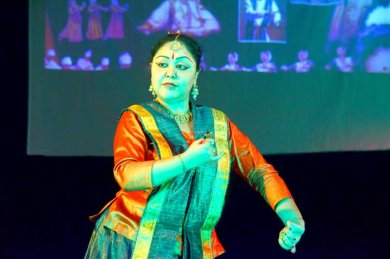 Sanchita Chakraborty 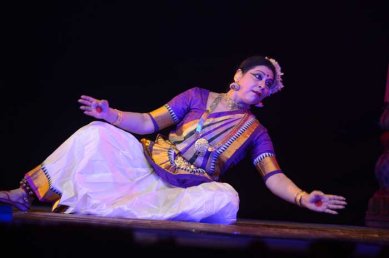 Mom Ganguly  Pratibha Sharma and group Pratibha and her troupe presented women based issue in Sattriya dance. It was interesting to see this approach, as otherwise the predominance of bhakti, devotion through the Bargeets, songs becomes monotonous. Pratibha selected the sequences from Ramayana - Ram, Sita and Lakshman going to forest, Ravana's kidnapping of Sita, the setubandh, building of the bridge, final battle between Ravana and Ram, and returning to Ayodhya, but before that Sita's Agnipariksha and then sending her away to forest after Mahapattabhishekam, the injustice done to her, and placing golden statue of Sita for the yajna followed by Sita's bhumi pravesh, as she returns to earth – all these incidents were performed with some vachanas, the commentary in Brajbuli. The return of Sita to earth was heart rending, Ram's helplessness and spreading his palms on the earth when Sita disappears, was performed with great intensity. Since Pratibha works as Research Assistant at Environmental Science Dept. at The Tezpur University, her choreography of Prakriti Puja based upon theme of Indra getting angry when Krishna advises devotees not to worship Indra but Govardhan, Indra sending torrential rains, the cowherds, animals, birds, vegetation all face hardships and Krishna lifting mount Govardhan, saves them. Pratibha has used projection of videos showing floods, devastation etc., and fury of nature to convey what we are doing disturbing the nature, metaphorically using projection as she wishes to connect it with mythological story. For common people this device works well and was much applauded. Her dancers gave her commendable support. Quick changes of costumes and formations were within boundaries of Sattriya and conveyed the message intelligently. Young male dancer Ankumoni Kapil, a Sattriya exponent, concluded the evening's presentation with Krishna Vandana, the traditional number which is a part of Sattriya dance and is performed by most of the dancers. His movements were graceful. Currently under the tutelage of Guru Narendra Baruah, Ankumoni is making progress. His Kaliya Daman episode was dramatic and forceful. He lives in nearby Guptakashi village and runs an academy where majority of his students are female dancers. He is a lecturer at the local college. He has good personality and shows promise of turning into a mature dancer. On second day, Pratibha's Kathak disciples opened the evening with tarana in Malkauns replete with mnemonic syllables of tode, tukde, footwork and chakkars. Dressed in eye catching white costumes the three dancers acquitted themselves well. The dancers when doing tatkar need not lift their skirts high as it looks unaesthetic. The foot mike carries the sound therefore the leg striking the floor need not be shown. 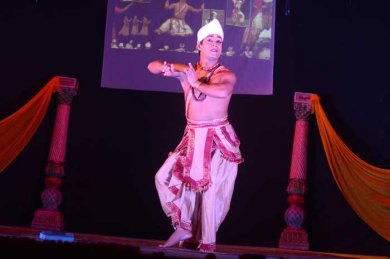 Ankumoni Kapil 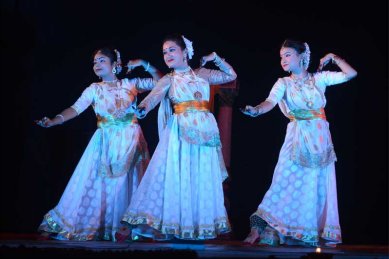 Kathak by Saptaswa students 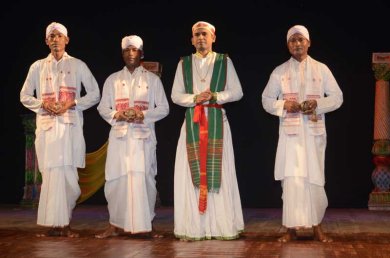 Vyas Ojapali by Dhrubajyoti Baruah and group 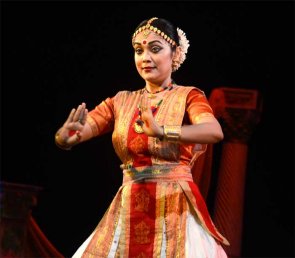 Lima Das Vyas Ojapali by Dhrubajyoti Baruah and group with lead Ojha singing and the Pali reinforcing the song with playing on cymbals was noteworthy for the simplicity and economy of movements. The main Ojha's white dress with colourful scarves and typical pugree like cap was impressive. His hand gestures were also economical and the troupe created favourable impression. The Dashavatara theme with hastas for each incarnation was in sync with the singing. The enactment and narration of story from Vanaprava from Mahabharata was communicative, though brief. Ojha Pali is a part of Vaishnava Sattriya dance form. Often there are larger groups with more members of Pali at the back. The highlight of the second day was a solo performance in Sattriya by Dr. Lima Das, a disciple of Guru Jatin Goswamy. She has a commanding stage presence. Graceful and arresting movements add to the charm of her performance. The solo based on Draupadi's theme was enacted with dignity. She etched every character distinctly during the game of dice, Draupadi's humiliation, Dushashan's defeat, Pandavas' helplessness and Krishna's timely succour were performed in an engaging manner minus exaggeration. The overall impression was aesthetic and dignified. From Kolkata, two Bharatanatyam dancers Mayuri Chakraborty and Sima Mondal gave a good account of their duet both in jatiswaram and in Todaya Mangalam Jaya Janaki Ramana. Both dancers performed in uniform style and were well tuned, concluding their teermanams perfectly. The nritta stood out for their disciplined approach. Jaya Janaki Ramana in Ragamalika evoked nostalgia. Adyar Lakshman's choreography for Yamini Krishnamurty has left an indelible impression on me. Garudagaman, annihilating Mura rakshasa and other references were danced with verve. I had not heard of these two dancers and was pleased to watch their commendable performance. Another dancer from Kolkata was Odissi dancer Ayona Bhaduri, trained earlier at Protima Bedi's Nrityagram and later on she moved to Kolkata and for some time had worked with Sharmila Biswas. She has a pleasant stage worthy personality. In pure dance performing Kiravani Pallavi choreographed by Guru Kelucharan Mohapatra, she brought out the "panhadi chaal," the movement of devotees pulling the chariot, a special movement which Kelubabu has incorporated in this pallavi. Bhubaneswar Misra's music is evergreen. Ayona performed with elan and verve. The traditional song "To laagi gopa danada mana re Kaliya" from the repertoire of Gotipua, choreographed by Kelubabu is another evergreen piece. On account of Krishna's pranks, Gopi complains that she is unable to go to Yamuna to fetch water, as Krishna accosts them on the way, asks for butter and makes advances on them. They love his playing flute and ask him to play but tell him not to show off. If he is a scion of a big family, she too is not a damsel from poor family. She chides him for his shameless behaviour and demands when he ferries them across in a boat to go to Mathura to sell curd. She tells him how to behave and not in full view of public act in such shameless manner. She closes door on him and sends him away. Ayona brought out all these nuances in a telling manner. With her large eyes and mobile visage the bhavas were registered in a delectable manner. She has started performing again after an interval of two years when she was completing her study of Public Administration and dance theory. I had last seen her two years ago in Delhi and had formed a favourable impression. She more than justified it with her command over the technique and expression. 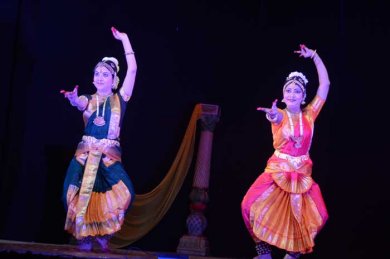 Mayuri Chakraborty and Sima Mondal 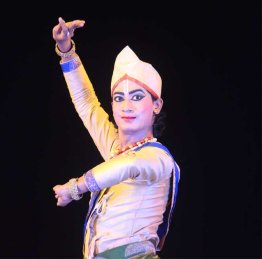 Bedant Bikash Dutta The finale was by young male Sattriya dancer Bedant Bikash Dutta. He belongs to traditional dancer family and has studied Sattriya dance from his mother. The prarthana, prayer and following numbers were adequate in terms of technique and repertoire that also included episode of Kaliya Daman. The movements of serpent were well enacted and also dancing of Krishna on serpent hood. The familiar story is known to the audience. What Bedant needs to do is to further expand his repertoire. He is young and can devote time to learning additional numbers which will bring variety thematically. From Natun Kamalabari Sattra, Barbayan Haricharan Bhuyan was specially invited to address the audience on both the days. Also young inmate Navin Chandra from Uttar Kamalabari Sattra had attended the two day festival. Local dignitaries were asked to felicitate the artists. Saptaswa as an institution has earned fame locally and they wish to have more of Sattriya workshops to generate interest among young dancers. They have been receiving some support from Sangeet Natak Akademi and Ministry of Culture. In the past, they have presented senior dancers from other states. With more planning they need to enlist financial support as to mount the two day festival every year is not an easy task. However, I was very pleased to meet so many dancers and students from Tezpur University and scholar Jintu Sarma, who displayed his enthusiasm throughout the festival.  Dr. Sunil Kothari is a dance historian, scholar, author and critic. He is honored with Padma Shri, Sangeet Natak Akademi award and Senior Critic Award from Dance Critics Association, NYC. Post your comments Please provide your name and email id when you use the Anonymous profile in the blog to post a comment. All appropriate comments posted with name & email id in the blog will also be featured in the site. |